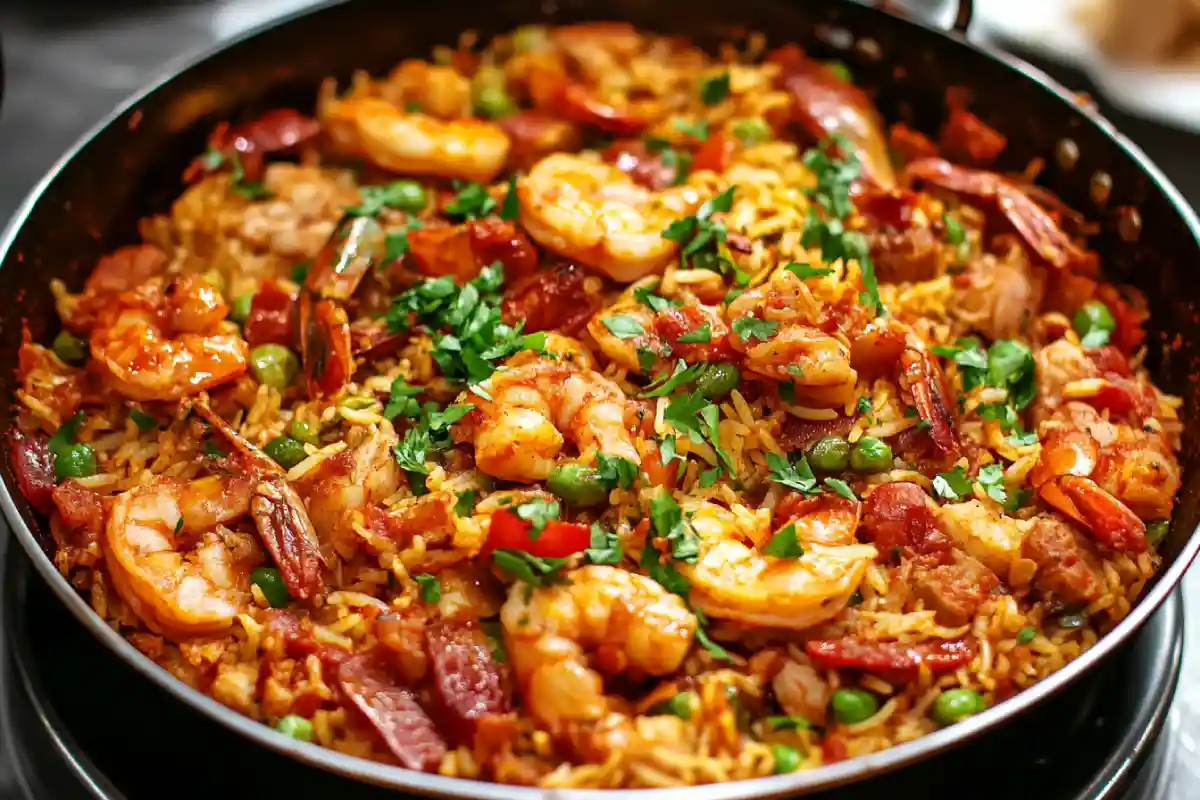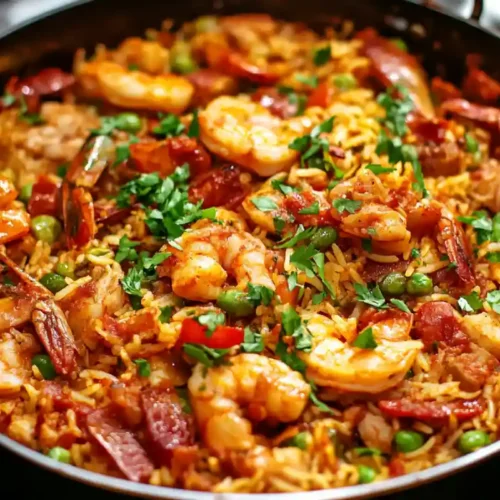
Table of Contents
Following the Alton Brown jambalaya method means layering smoke, spice, and the “trinity” with clock-work precision. After cooking the recipe three times—once exactly as written and twice with chicken turkey and beef sausage swaps—I locked-in a 45-minute stovetop version that nails Alton’s depth while fitting everyday weeknight timing.
What is Jambalaya?
Jambalaya is a bold and flavorful dish deeply rooted in Louisiana cuisine. With influences from Spanish, French, and West African cooking, this one-pot meal is known for its rich spices, smoky proteins, and hearty rice base. It is a staple of both Creole and Cajun kitchens, with each region offering a unique spin on the classic dish.
There are two main types of jambalaya:
- Creole Jambalaya (Red Jambalaya): This version includes tomatoes, which give the dish a rich, slightly tangy flavor.
- Cajun Jambalaya (Brown Jambalaya): Made without tomatoes, this variation gets its deep brown color from browning the meat and cooking the rice in rich seasonings.
How Jambalaya Differs from Other Southern Dishes
Although jambalaya shares some similarities with gumbo and étouffée, there are key differences:
- Gumbo is more of a stew, served over rice rather than cooking the rice in the pot.
- Étouffée has a thicker, roux-based sauce, often featuring crawfish or shrimp.
Many food historians believe jambalaya evolved from paella, brought to Louisiana by Spanish settlers. Since saffron was scarce, cooks substituted local spices, creating a dish uniquely tied to the region’s ingredients. To explore more on this classic dish, check out this chicken and sausage jambalaya recipe that highlights traditional Creole flavors.
The Holy Trinity of Jambalaya
One essential component of authentic jambalaya is the Holy Trinity—a foundational blend of:
- Onions
- Bell peppers
- Celery
This combination, similar to the French mirepoix, adds a deep, savory base to the dish. Whether you choose Alton Brown jambalaya or a more traditional style, this aromatic trio ensures the perfect balance of flavor.
For those looking to add a Mediterranean twist to their jambalaya, try pairing it with a tangy olive relish for a bold, briny contrast.
Step-by-Step Recipe for Alton Brown’s Jambalaya
Cooking Alton Brown jambalaya requires a methodical approach to ensure each ingredient contributes to the dish’s bold, layered flavors. By following these steps, you’ll create a well-balanced, authentic jambalaya that captures the essence of Louisiana cuisine.
1. Prepping the Ingredients
Before you start cooking, it’s essential to prepare all the components:
- Chop the vegetables – Dice the onions, bell peppers, and celery to form the Holy Trinity of jambalaya.
- Slice the Beef or Chicken Andouille Sausage – Cut it into even rounds to ensure uniform cooking.
- Season the chicken – Coat with salt, pepper, and Cajun seasoning for maximum flavor.
- Measure the rice and liquids – Use the correct ratio to maintain the perfect texture.
2. Building the Flavor Base
Once the ingredients are prepped, it’s time to develop a deep, smoky taste:
- Brown the Beef or Chicken Andouille Sausage and chicken – Sauté in a large pot to create a rich, caramelized base.
- Sauté the vegetables – Add the onions, peppers, and celery, stirring until they become soft and fragrant.
- Stir in garlic and spices – This enhances the depth of the dish before adding liquid.
3. Simmering and Cooking the Rice
This step ensures the rice absorbs every bit of flavor:
- Add the rice to the pot – Stir well so it gets coated with seasonings and meat drippings.
- Pour in chicken stock and tomatoes (for Creole-style jambalaya) – Bring to a simmer and cover.
- Cook on low heat – Let the rice absorb the liquid, stirring occasionally to prevent sticking.
4. Final Touches and Serving
For the last step, you’ll add the finishing elements:
- Toss in the shrimp – If using, add shrimp during the final 5 minutes of cooking to keep them tender.
- Fluff the rice – Once fully cooked, gently stir to distribute ingredients evenly.
- Garnish and serve – Sprinkle chopped parsley or green onions for a fresh touch.
To pair your jambalaya with another Louisiana favorite, consider serving it alongside a muffuletta sandwich. Check out this guide on muffuletta bread for the perfect homemade version of this iconic sandwich.
Common Mistakes to Avoid When Making Jambalaya
Even experienced cooks can make mistakes when preparing Alton Brown jambalaya. However, being aware of common pitfalls can help you achieve the perfect balance of flavors and textures. Below are some key errors to avoid, along with solutions to ensure your jambalaya turns out just right.
1. Overcooking the Rice
Rice is a crucial element in jambalaya, and cooking it incorrectly can ruin the dish. Avoid these mistakes:
- Adding too much liquid – This can make the rice mushy.
- Not stirring occasionally – Prevents rice from sticking to the bottom of the pot.
- Cooking at too high a heat – Can lead to uneven texture.
Tip: Use the right ratio of stock to rice, typically 2:1, and let it simmer on low heat without excessive stirring.
2. Using the Wrong Type of Sausage
Not all sausages are equal when it comes to jambalaya. Avoid using mild or bland sausages that won’t contribute to the dish’s bold flavors.
- Best Choice: Beef or Chicken Andouille Sausage – it provides a smoky, spicy depth.
- Not Recommended: Breakfast or Italian sausage – they lack the proper seasoning.
3. Not Developing Flavors Properly
Skipping essential steps can lead to a dish that lacks depth. To maximize flavor:
- Sear the meats first to lock in richness.
- Sauté the Holy Trinity (onions, bell peppers, celery) until soft and fragrant.
- Layer the seasonings instead of adding them all at once.
4. Choosing the Wrong Rice
Different rice varieties absorb liquid differently, affecting the final texture. Here’s a quick guide:
| Rice Type | Recommended? | Why? |
|---|---|---|
| Long-Grain White | ✅ Yes | Stays firm and fluffy |
| Jasmine or Basmati | ❌ No | Too aromatic for traditional jambalaya |
| Short-Grain Rice | ❌ No | Can become too sticky |
| Brown Rice | ✅ Yes (with adjustments) | Requires more liquid and longer cooking time |
5. Overcooking the Shrimp
If you’re making seafood jambalaya, adding shrimp too early can result in a rubbery texture. Always:
- Stir in the shrimp during the final five minutes of cooking.
- Remove the pot from heat once shrimp turn pink.
For another flavor-packed Louisiana dish, check out this olive salad recipe to pair with your jambalaya!
FAQs About Jambalaya
Many people have questions about Alton Brown jambalaya and its unique approach to this classic Louisiana dish. Below, we address some of the most commonly asked questions to help you understand the key elements that make jambalaya so flavorful and well-balanced.
What is Alton Brown’s favorite dish?
Alton Brown has created a variety of innovative recipes, but his love for Southern comfort food is well known. While he enjoys many classic dishes, Alton Brown jambalaya stands out as a fan favorite due to its rich history and bold flavors. His version of the dish incorporates precise cooking techniques, ensuring that every bite is packed with smoky, savory goodness.
What is the Holy Trinity of jambalaya?
The Holy Trinity in jambalaya refers to a blend of onions, bell peppers, and celery. This aromatic base is essential in Cajun and Creole cooking, creating the deep, savory flavors that make Alton Brown’s jambalaya and other Louisiana dishes recipes so rich and well-balanced. To explore more authentic Louisiana dishes recipes, check out this guide to Louisiana dishes for inspiration!
Is jambalaya supposed to be thick or soupy?
Jambalaya can be either thick or slightly soupy, depending on the style. Cajun jambalaya is drier, while Creole jambalaya has a wetter consistency due to the addition of tomatoes. If your jambalaya is too thick, add a bit of stock; if it’s too soupy, let it simmer uncovered to reduce the liquid.
What makes jambalaya taste like jambalaya?
The signature taste of jambalaya comes from a combination of smoky Beef or Chicken Andouille Sausage, Cajun seasoning, and slow-cooked rice that absorbs all the rich flavors. The use of well-balanced spices and proper cooking techniques ensures the dish has its characteristic depth and boldness.
Conclusion
Jambalaya is more than just a meal—it’s a reflection of Louisiana’s rich culinary heritage. By following Alton Brown jambalaya techniques, you can create a dish that captures the essence of both Cajun and Creole traditions. Whether you prefer a smoky, tomato-free version or a slightly saucier Creole-style jambalaya, the key lies in layering flavors, selecting quality ingredients, and cooking with precision.
One of the reasons Alton Brown jambalaya stands out is its balance of spices, proteins, and textures. The combination of smoky Beef or Chicken Andouille Sausage, perfectly cooked rice, and the Holy Trinity of vegetables ensures a dish that is both hearty and satisfying. More importantly, his methodical approach guarantees consistent results, making it easy for anyone to master this Southern classic.
If you’re looking to enhance your meal, consider pairing jambalaya with homemade garlic butter for extra depth of flavor. Try this garlic butter recipe to complement the bold, savory notes of your dish. By experimenting with different pairings and seasonings, you can make Alton Brown jambalaya your own while still honoring its traditional roots.

Alton Brown Jambalaya
Ingredients
- 1 lb Chicken thighs Boneless skinless, cut into chunks
- 12 oz Beef or Chicken Andouille Sausage Sliced into rounds
- 1 cup Onion Diced
- 1 cup Bell peppers Diced red or green
- 1 cup Celery Diced
- 3 cloves Garlic Minced
- 2 cups Long-grain white rice Uncooked
- 4 cups Chicken stock Low-sodium preferred
- 1 can Diced tomatoes 14.5 oz undrained (optional for Creole style)
- 1 tbsp Cajun seasoning Adjust to taste
- ½ tsp Dried thyme –
- ½ tsp Smoked paprika Enhances depth of flavor
- ¼ tsp Cayenne pepper Optional for extra heat
- 2 tbsp Olive oil For sautéing
- 2 tbsp Worcestershire sauce Adds depth
- 2 pcs Bay leaves Remove before serving
- ½ cup Green onions Chopped for garnish
- To taste – Salt and pepper Adjust as needed
Instructions
- Sauté the Meats: Heat olive oil in a large Dutch oven over medium heat. Add the sliced Beef or Chicken Andouille Sausage and cook until browned, about 3-4 minutes. Remove and set aside. In the same pot, add the chicken pieces, season with salt and pepper, and cook until golden brown. Remove and set aside.
- Cook the Vegetables: In the same pot, add the diced onions, bell peppers, and celery. Sauté for 5 minutes until softened. Stir in the garlic and cook for an additional 30 seconds.
- Build the Flavor Base: Return the Beef or Chicken Andouille Sausage and chicken to the pot. Add Cajun seasoning, thyme, smoked paprika, and cayenne pepper. Stir well to coat everything in spices.
- Simmer the Jambalaya: Add the uncooked rice and stir to combine. Pour in the chicken stock, Worcestershire sauce, and diced tomatoes (if using). Toss in the bay leaves. Bring to a boil, then reduce the heat to low. Cover and let simmer for 25-30 minutes, stirring occasionally.
- Check the Rice & Final Touches: Once the rice is tender and has absorbed the liquid, remove the bay leaves. Fluff the rice with a fork.
- Garnish and Serve: Sprinkle chopped green onions over the top. Serve hot and enjoy!
Notes
- If you prefer a Cajun-style jambalaya, omit the tomatoes.
- To increase the spice level, add extra cayenne pepper or hot sauce.
- For a seafood variation, add shrimp during the last 5 minutes of cooking.
- Jambalaya tastes even better the next day as the flavors meld!
